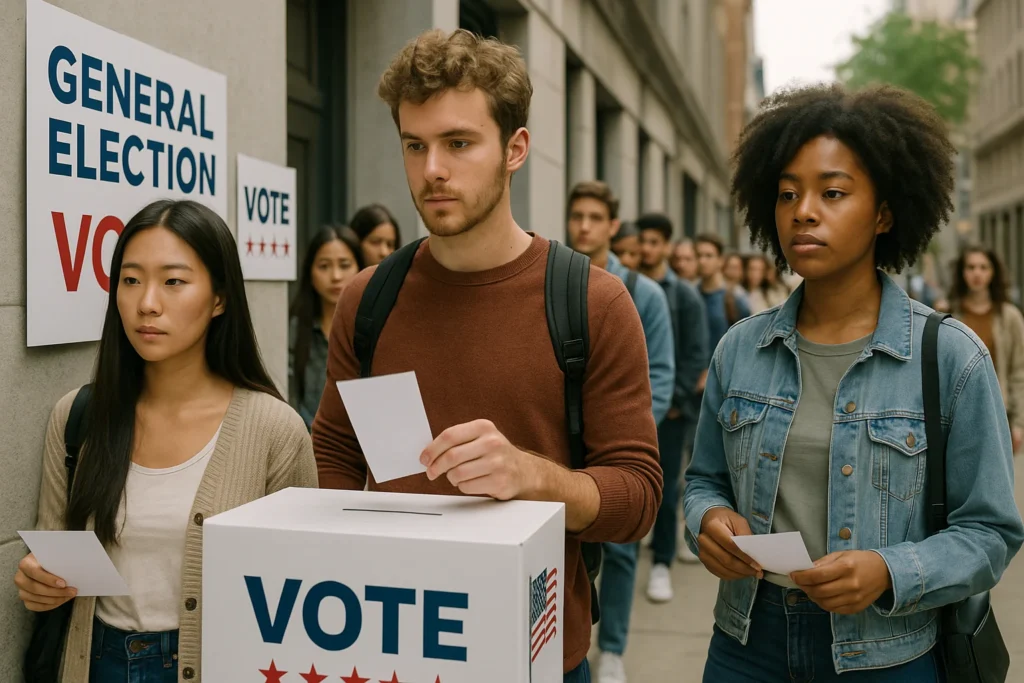Introduction: A New Political Force Awakens
For a long time, the image of a typical voter might have been someone older, perhaps with decades of experience heading to the polling booth. But in 2025, that picture is rapidly changing. Across the globe, from the bustling streets of Delhi to the digital town squares of American cities, a powerful new force is emerging: young voters aged 18 to 30. They are not just casting ballots; they are shaping political conversations, demanding attention for their unique concerns, and redefining what it means to be politically engaged.
This isn’t just a ripple; it’s a wave. After years of being underestimated, Millennials and Gen Z are stepping into their power, making their voices heard on issues like climate change, digital freedom, and social justice. This article will explore how these young people are becoming a decisive force in key elections around the world, how they’re using modern tools like TikTok and Instagram to spread their message, and what challenges they still face in their quest for a more representative future.
The Rising Tide: Youth Voter Influence in 2025 Elections
Across continents, elections scheduled for 2025, or major recent ones that set the stage, are seeing (or have seen) the youth vote matter more than ever. Their sheer numbers, combined with increasing engagement, mean politicians simply can’t ignore them anymore.
Key Battlegrounds for the Youth Vote
- India: While the recent national election captivated the world in 2024, several Indian states are preparing for crucial elections in 2025. With a vast youth population, this demographic played a significant role in the 2024 general election, showing that young people are keenly aware of issues like employment and social equity. Their continued participation in state-level contests will be vital in shaping local governance.
- United States: Though 2025 primarily features state and local elections, the strong youth engagement seen in the 2024 presidential election highlighted their growing influence. Young people, particularly Gen Z, showed up in significant numbers, often swinging outcomes in close races. The trends from 2024 are setting the stage for increased youth participation in subsequent elections.
- Indonesia: The world’s third-largest democracy, Indonesia, held its presidential and legislative elections in 2024, where over half of all registered voters were under 40. This massive youth demographic proved decisive, making it clear that candidates must cater to their concerns about jobs, education, and digital access.
While youth voter turnout might still be lower than older age groups in some places, their growth rate in participation is often higher. In tight electoral races, even a small increase in youth turnout can shift the balance, making their vote a coveted prize for any political party.
Their Issues, Their Future: What Matters to Young Voters
Unlike older generations, young voters often prioritize a distinct set of issues that directly impact their long-term future. For Millennials and Gen Z, the world they inherit is at stake, and their political engagement reflects this urgency.
Driving the Agenda
- Climate Action: Perhaps no issue unites young voters more globally than climate change. From Friday For Future protests to advocating for green policies, Gen Z sees the climate crisis as an existential threat. They demand aggressive action, clean energy transitions, and sustainable development from their leaders, often viewing it as a core component of social justice.
- Digital Freedom and Privacy: Growing up online, young people keenly understand the importance of digital freedom. They are concerned about data privacy, government surveillance, censorship, and the power of tech giants. Debates around net neutrality and the regulation of AI often resonate deeply with this demographic.
- Job Security and Economic Opportunity: Many young people are entering a challenging global economy. High youth unemployment rates, the rising cost of living, and an increasingly competitive job market make job security and fair economic opportunities critical. They seek policies that support living wages, affordable housing, and accessible education that leads to meaningful careers.
- Social Justice and Equality: Issues of social justice—including racial equality, LGBTQ+ rights, gender equity, and human rights—are central to youth political engagement. They are often strong advocates for inclusivity and challenge systemic discrimination, using their voices to push for a more equitable society.
- Democracy and Governance: Many young voters are also concerned about the health of democratic institutions, advocating for transparency, accountability, and a political system that truly represents all voices.
These issues are not just abstract concepts for young people; they are intertwined with their daily lives and their vision for a just and sustainable future.
The New Campaign Trail: TikTok, Instagram, and Independent Voices
Forget traditional billboards and TV ads. In 2025, the political battleground for youth votes is often found on their smartphones. TikTok, Instagram, and independent media have become powerful tools for campaign messaging, allowing politicians and activists to connect directly with young audiences in new and engaging ways.
Campaigning in the Digital Age
- TikTok’s Power: Short, snappy videos on TikTok can go viral, reaching millions of young users in hours. Politicians and their teams are using the platform for quick policy explainers, behind-the-scenes glimpses, and even lighthearted takes on political issues. It’s a platform where authenticity often beats polished corporate messaging.
- Instagram for Infographics and Engagement: Instagram continues to be a key visual platform. Campaigns use it for eye-catching infographics that break down complex policies, share impactful images from rallies, and host live Q&A sessions where candidates can interact directly with young voters.
- Independent Media and Influencers: Young voters often express distrust in traditional news outlets. Instead, they turn to independent content creators, podcasters, and social media influencers for political analysis and news. Savvy campaigns are recognizing this shift, working with trusted influencers to spread their message in a way that feels authentic rather than like a paid advertisement. This blend of information and entertainment, or “infotainment,” is crucial for engaging the digital-native generation.
This digital-first approach means campaigns must be agile, responsive, and understand the nuances of online culture to effectively reach and mobilize young voters.
From Hashtags to Helm: Youth-Led Movements and Candidates
The rising political engagement of young people isn’t just about voting; it’s about leading. In 2025, we’re seeing more youth-led political movements gain momentum, and a growing number of first-time candidates under 30 stepping up to run for office.
Fresh Faces, Bold Voices
- Global Youth Activism: Movements like the global climate strikes, often initiated and led by teenagers and young adults, have fundamentally shifted public discourse and forced governments to confront environmental issues. These movements demonstrate the power of collective youth action to bring about change outside traditional political structures.
- Demanding Representation: Young people are increasingly frustrated with a political landscape dominated by older generations who may not fully grasp their concerns. This frustration is fueling a desire for more direct representation, leading many to consider running for office themselves.
- First-Time Candidates: While exact numbers for 2025 are still emerging, the trend of younger politicians entering the fray is undeniable. These candidates often run on platforms focused on issues close to young voters’ hearts, using their personal experiences to connect with constituents. They leverage social media and grassroots organizing to build campaigns that challenge established political norms.
- Formal Participation: Beyond elections, young people are also getting involved in formal political structures, joining youth parliaments, student councils, and political party youth wings, learning the ropes and preparing for future leadership roles.
These youth-led efforts signify a deeper commitment to political change, moving beyond online activism to direct participation in shaping governance.
The Roadblocks: Misinformation, Suppression, and Apathy
Despite their growing power, young voters face significant hurdles. The digital landscape that empowers them also presents challenges, and traditional barriers to voting still disproportionately affect this demographic.
Navigating a Complex Landscape
- Misinformation and Disinformation: Social media, while a powerful tool, is also a breeding ground for misinformation. Young voters, who often get their news from less traditional sources, are particularly vulnerable to false or misleading political content designed to sow confusion or discourage participation. Campaigns targeting young voters with disinformation are a major concern for the integrity of elections in 2025.
- Voter Suppression: Deliberate attempts to make voting harder disproportionately affect young people and first-time voters. Tactics like restrictive voter ID laws, purges of voter rolls, limited polling places (especially on college campuses), and complex registration processes can create significant barriers, even if unintentional.
- Apathy and Disillusionment: Despite the overall increase in engagement, a segment of youth voters still struggles with apathy. This can stem from a feeling that their vote doesn’t make a difference, that politicians don’t truly represent their interests, or that the political system is too broken to fix. High-profile political scandals or unfulfilled promises can contribute to this disillusionment.
Overcoming these challenges requires concerted efforts from educators, fact-checkers, policymakers, and youth advocates to ensure young people are informed, empowered, and have fair access to the ballot box.
Case Studies: Viral Campaigns and Grassroots Power
To truly understand the impact of young voters, it helps to look at real-world examples of how their energy translates into political action. While specific 2025 viral campaigns are still unfolding, lessons from recent years illustrate the power of digital activism and grassroots organizing.
Stories of Impact
- Climate Strikes’ Global Resonance: The global youth climate strike movement, though not directly electoral, showcased the power of young people to put an issue at the very top of the political agenda. Millions of students walked out of schools, forcing politicians worldwide to acknowledge the urgency of climate action and influencing electoral platforms.
- Digital Mobilization in India (2024): In the lead-up to India’s 2024 general elections, youth groups and activists leveraged platforms like YouTube, Instagram, and local language messaging apps to conduct massive voter registration drives and “get out the vote” campaigns. They created engaging content explaining complex political issues in simple terms, debunking misinformation, and encouraging peers to participate, demonstrating the power of grassroots digital organizing.
- “Youth Vote” Hashtags and Online Movements: In various countries, specific hashtags and online movements have successfully mobilized young people. These often originate organically, sharing personal stories, creating memes, and organizing online discussions that translate into real-world political action, from signing petitions to attending rallies and, crucially, voting.
- First-Time Candidate Success Stories: While specific 2025 examples are still emerging, recent elections have seen young, previously unknown candidates leverage social media and direct outreach to challenge established politicians. These campaigns often rely on volunteer power and digital savvy to overcome traditional funding gaps, proving that passion and connection can be powerful political assets.
These examples highlight that young people are not just passive consumers of political messages; they are active creators, organizers, and mobilizers, using every tool at their disposal to shape their world.
Conclusion: The Youth Wave Reshaping Our Future
The Global Elections of 2025 are undeniably influenced by a burgeoning and dynamic force: the young voter. Far from being apathetic, Millennials and Gen Z are demonstrating a powerful commitment to political engagement, driven by urgent concerns over climate change, digital freedom, job security, and social justice.
Their activism is amplified by the strategic use of platforms like TikTok and Instagram, transforming how campaigns communicate and how citizens connect with politics. This era is also witnessing the rise of vibrant youth-led political movements and a new generation of first-time candidates under 30, bravely stepping forward to represent their peers. While significant challenges persist, including the pervasive threat of misinformation, voter suppression, and the lingering specter of apathy, the energy and determination of young people are reshaping the political landscape.
Ultimately, the youth wave in 2025 is a testament to a generation that understands the stakes are high. They are not waiting for change; they are actively driving it, using their voices, their votes, and their digital savvy to build a future that reflects their values and addresses the critical issues of their time. The world is watching, and the youth are leading the way.



